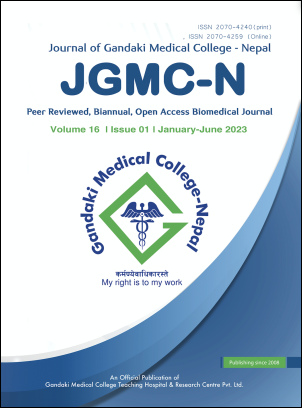Localizing tip of conus medullaris in hospital visiting adults using MRI
DOI:
https://doi.org/10.3126/jgmcn.v16i1.54591Keywords:
Conus medullaris, magnetic resonance imaging, spinal cord, terminationAbstract
Introduction: Generally, the spinal cord ends at the level between the first and second lumbar vertebrae. There are many studies published globally, yet no article has been published concerning this title in our settings. The objective of this study was to determine the tip level of conus medullaris by the Magnetic Resonance Imaging (MRI) in living humans in Nepalese population.
Methods: Images of the MRI done between August 2019 to June 2021 were accessed through the database of the radiology department for defining the level of conus medullaris. The termination level of conus medullaris was rescored in relation to the upper, mid, and lower third of the adjacent vertebrae and the intervertebral disc. Input data was processed in Microsoft Excel which was later analyzed by SPSS 20.0.
Results: Of the total, 202 study population, a higher number of spinal cords terminated at lower one-third of L1 vertebrae, accounting for 51 (females 26 and males 25) followed by L1-L2 intervertebral disc comprising only 35 (males 19; females 16). No significant differences in number existed between the two sexes having conus medullaris termination at both levels. Most of the cases who were in the age group of 40-49 years old, termination of CM was noted in L1 with the most common shape being the central type C, accounting for 38% (78/202).
Conclusions: The conus medullaris was terminated mostly at lower one third of L1 vertebral body in our settings with no gender difference.
Downloads
Downloads
Published
How to Cite
Issue
Section
License
Copyright (c) 2023 Madan Thapa, Shyam Sundar Parajuly, Manish Kiran Shrestha, Roshan Pangeni, Bhim Bahadur Thapa, Santosh Baral

This work is licensed under a Creative Commons Attribution-NonCommercial 4.0 International License.
This license allows reusers to distribute, remix, adapt, and build upon the material in any medium or format for noncommercial purposes only, and only so long as attribution is given to the creator.




